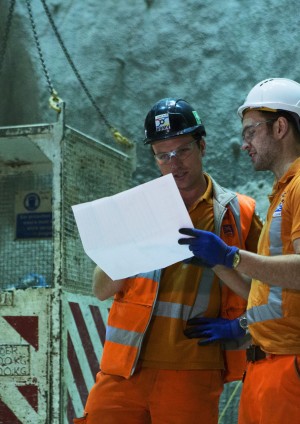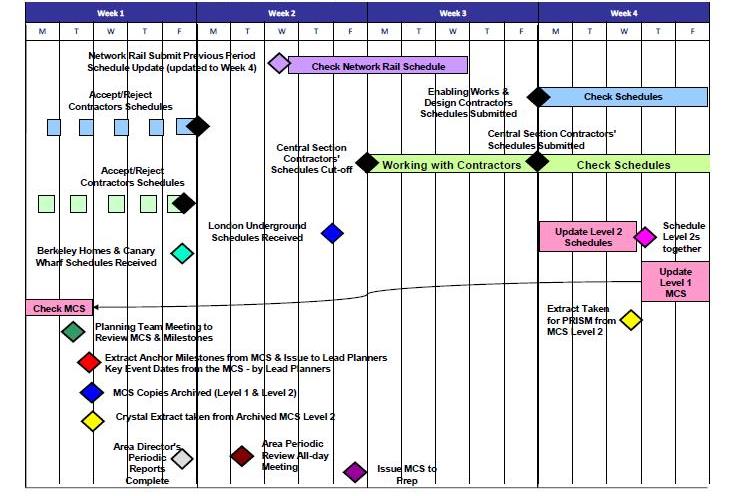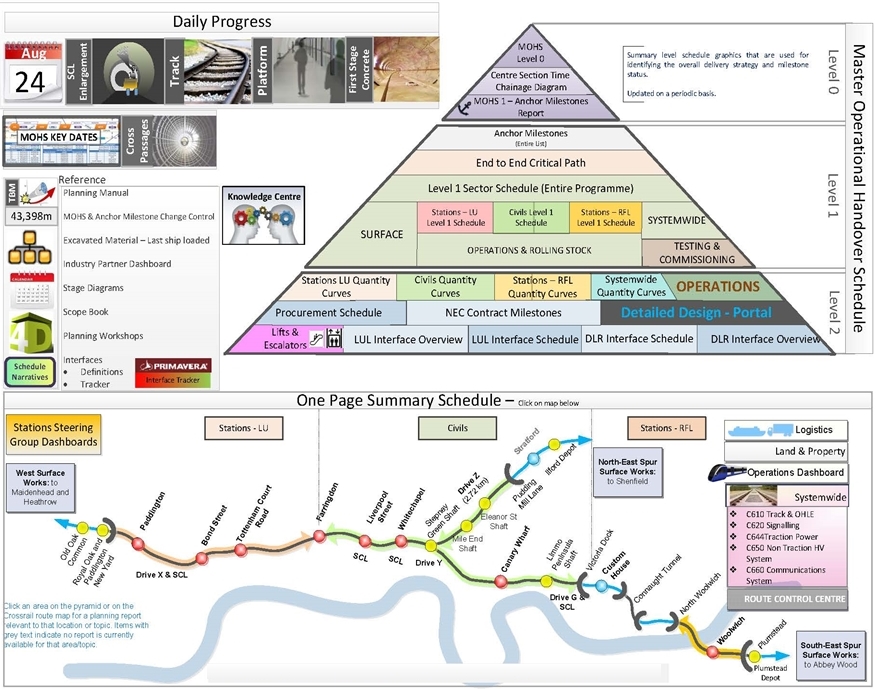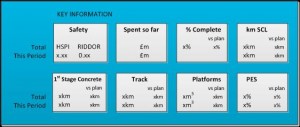
Schedule Reporting
Document
type: Micro-report
Author:
Rob Little
Publication
Date: 26/02/2016
-
Abstract
Reporting is a necessary requirement for all projects and developing the methodologies adopted by Crossrail for schedule management and reporting has been key to the success of the programme so far. This learning legacy paper provides an overview of some of the key principles adopted by Crossrail in the delivery of the programme and describes lessons learned around the importance of periodic reporting cycles, establishing anchor milestones and annual baseline to realign common objectives and interfaces.
-
Read the full document
Introduction and Industry Context
The planning function in Crossrail supports the overall reporting requirements of the business and has established processes and deliverables that have been in place since 2011. The methodology is largely detailed in the Planning and Scheduling Handbook and summarised in this learning legacy micro-report
Reporting of Planning Information
The rail industry in the United Kingdom works on a standardised 4 week reporting cycle and Crossrail follows this, preparing reports that inform review meetings at both project and programme levels within the organisation.
Periodic reports are prepared to cover:
- Schedule and project and programme levels
- Design
- Interfaces with Industry Partners
- Lifts and Escalators
- Critical Path(s)
- Anchor Milestones
- NEC Milestones
In addition Crossrail has maintained the publication of Daily Reports tracking the progress of Critical construction activities for the following:
- TBM Tunnelling
- Track Installation
- Sprayed Concrete
- First stage Concrete
- Platform Edge Screen
- Platform Construction (concrete)
Reporting Cycle
The reporting cycle follows a standard four weekly process commencing on the 1st April of every year with thirteen four week periods in any year. Annual baselines have been maintained initially in Crossrail’s Master Control Schedule (MCS) and latterly in the renamed Master Operational Handover Schedule (MOHS).
Towards the completion of every period, Crossrail commences the process of updating both levels of the MOHS; programme and project. From these updates, Crossrail generates periodic reports that inform the business on its progress towards the milestones set out in its plans and also forecasts any deviations that have been foreseen.
Crossrail utilises a Primavera P6 schedule database to plan its projects and store periodic schedule information and this forms creates the information from which CRL generates its management reports.
Figure 1: MOHS 4 Weekly Reporting Cycle
The reporting cycle is also documented in section 2.2 of the The Planning and Scheduling Handbook.
The Planning Handbook
Crossrail’s Planning and Scheduling Handbook defines its approach to schedule management in a series of Desk Top Instructions. It provides details of specific activities and coding that is required within the MOHS so that standard reports can be prepared and published.
Publishing Reports
Crossrail’s Planning Page on the intranet as shown in Figure 2 below has been a successful innovation for the publication of schedule information and reports. Developed during the early stages of the construction phase of the project it has provided a centralised portal and point of reference for the Crossrail team to access pertinent planning reports.
Figure 2: Intranet Planning Page provided a central portal for access to reports
Anchor ID Anchor Milestone Description MOHS Baseline Early Date MOHS Baseline Late date Actual/ Forecast Variance (BL Early – forecast) RAG Change from last period Axxx Cxxx – dd-mm-yy dd-mm-yy dd-mm-yy +/- days R/A/G ↑↓↔ Axxx Cxxx – dd-mm-yy dd-mm-yy dd-mm-yy +/- days R/A/G ↑↓↔ Axxx Cxxx – dd-mm-yy dd-mm-yy dd-mm-yy +/- days R/A/G ↑↓↔ Figure 3: Master Operational Handover Schedule (MOHS) Crossrail Anchor Milestone Periodic Reporting Template.
Board Report
The Board Report is a key document for communicating schedule information to key stakeholders including Crossrail’s Sponsors, the Department for Transport and Transport for London. Strategic schedule information has been requested to inform readers about the periodic performance of Crossrail and towards the achievement of corporate level objectives. Key information is provided from the daily progress reports and includes key metrics shown in Figure 4 below.
Figure 3: Key Schedule Progress Information provided in the Board Report
Semi Annual Construction Report
Production of the Semi Annual Construction Report (SACR) is a reporting obligation in the Crossrail Project Development Agreement (PDA). It provides Crossrail’s Sponsors with a detailed report on project progress, cost, risk and schedule. It is an important source of critical schedule information and progress towards the achievement of annual as well as strategic goals.
Schedule information that feeds into this report includes:
- Level 0 Master Operational Handover Schedule
- Quantitative Schedule Risk Analysis (QSRA)
- Anchor Milestone progress
- Critical path analysis
- Planning assumptions
- Programme Development Agreement (PDA) Milestones progress
- Operations progress
- Progress of Crossrail Surface works
Lessons Learned
Reporting is a necessary requirement for all projects and developing the methodologies adopted by Crossrail for schedule management and reporting has been key to the success of the project so far. Establishing and following a periodic cycle was fundamental to the project to ensure alignment of all projects at set moments in time. This drives the consistency in information and instils a discipline of common deadlines for reporting and schedule updating.
At an early stage of the delivery phase of Crossrail the Delivery Partner and Programme Partner were merged into an Integrated Team which significantly reduced any overlaps and repetition within Crossrail’s planning function. From this merging of the teams came a common approach to schedule management and reporting that was captured in the initial version of the Planning Manual and the associated Desk Top Instructions. Having established an integrated team, the reporting processes were clearer, avoided duplication, were more efficient and significantly improved working relationships within the planning function at Crossrail.
Reporting requirements have evolved during the project however some of the fundamentals such as progress against Anchor Milestones and strategic Key Milestones have consistently acted as a health check on the progress and performance of the project. This is common to most major infrastructure projects and Crossrail is no different. Selection of the Anchor Milestones to report against follows an established process of annual baselining of the programme. This has allowed the project to reset the MCS/MOHS and associated milestones to realign common objectives and interfaces on an annual basis. This has benefited the project as the project has moved through the delivery phase and allowed for interfaces to be better understood and evaluated as circumstances change or mitigation actions agreed.
Recommendations for Future Projects
Establish Requirements
The reports required by the programme drive requirements for milestones and settings/coding in Primavera. Clarity on the information required in reports has driven standardised approaches which Crossrail has successfully documented in Desk Top Instructions. This provides consistency of information which can then be amalgamated to provide a programme reports from which management action can be instigated.
Use Standardised Timetables
The use of a 13 period annual calendar and an annual baseline with a suitable change process has provided a disciplined approach to planning and the reporting of planning information.
-
Authors
Rob Little - Crossrail Ltd, The Nichols Group
Head of Planning
Rob has worked with Nichols since 2002 holding senior planning positions on some of London’s most significant railway infrastructure projects including Metronet, Thameslink and Crossrail. Rob’s experience includes the construction of Hong Kong International Airport, infrastructure projects in southern China and telecoms experience to build global long distance capacity to support the growth of the internet.
Rob is a Chartered Mechanical Engineer with an MBA.


